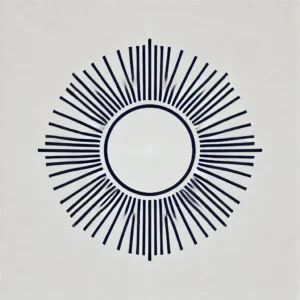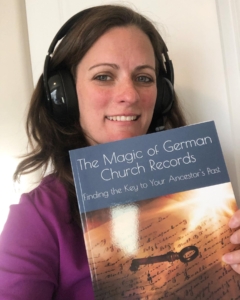I recently attended the Foundation for East European Family History Studies Conference (known as FEEFHS) in Salt Lake City, Utah. It was my first time attending, and I really enjoyed getting to go to the presentations – normally, I have my own booth and am speaking myself, so I never get the chance to learn from the other sessions. But this time, I decided to treat myself to an educational trip, and I’m so glad I did!
Below, find 7 German genealogy tips that I learned at this conference. I hope you enjoy them as much as I did!
- “Strohhochzeit” (Straw Wedding) Symbol: The below symbol, or something similar looking (it’s on the rarer side; I couldn’t find an example online, so I had to try to generate it with ChatGPT), is something that I have seen in records from time to time. It looks like a sun, and can be found in the margins of a marriage record. In Milan Pohontsch’s presentation, he explained that this mysterious symbol stands for “Strohhochzeit” – a wedding in which the bride was no longer a virgin. A virgin bride, as he explained, would have worn a crown of flowers on her head. But non-virgin brides were required to wear a crown of straw – hence the “crown of straw” symbol next to the marriage entry. Fascinating!

2. Swiss into Baden-Württemberg: Have Swiss ancestors? In Fritz Juengling’s presentation, I learned that there was a large migration of Swiss immigrants into Baden Württemberg after the Thirty Years War (1618-1648). Much of the area had been wiped out during the war, and Swiss immigrants helped to resettle the area. So if you have ancestors from Baden-Württemberg, they might actually have originally been from Switzerland! Fritz also mentioned a great website for Swiss research – the Register of Swiss Surnames.
3. The Use of Feast Days in Church Records: If you have my book The Magic of German Church Records, you’ll remember that pastors sometimes used feast days in place of dates for baptisms, marriages, and deaths. For example, you might see that your ancestor was baptized on the second Sunday of Advent, or something even more obscure, such as that they were baptized on “Kantate”. In this blog post, I explain this practice in more detail, and also mention the fact that you can convert these feast days to actual dates with the website Kirchenkalendar (church calendar). What I learned from Milan’s presentation, however, was that this practice was likely in use until about 1870 – that is the latest that he himself has seen a feast day used in place of a date in a church record. Good to know!

4. The Start of OFBs: If you’ve been a German genealogist for a while, you will have heard of Ortsfamilienbücher. also know as Ortssippenbücher, or family heritage books for a specific town. While I know how to use them and how to help people find them, I’ve always wondered when exactly these books were compiled. Fritz answered my question during his presentation, stating that they started in the first half of the 20th-century or so, on a village by village basis, and some villages are still updating them today! Another interesting fact: I later learned that the original reason these books were created was to prove a person’s Aryan ancestry during the 1930s and 1940s, although after the war their creation continued for genealogical purposes only. (A great source for OFBs is CompGen – see their list of towns with books here).
5. Werner Hacker Emigration List: In Jim Beidler’s presentation, I learned all about a new resource to me – Werner Hacker’s emigration list. a register of emigrants from southwest Germany to America and to the East in the eighteenth-century. These lists include name, year of birth, place of origin, year of emigration, and occupation, sourced from administrative accounts, emigration permits, church record notations, and so on. Jim also told us that in the 1700s, only 15% of emigrants went to America – the other 85% went East!
6. AI with Footnotes: In James Tanner’s presentation on AI, he sang the praises of Microsoft CoPilot – a chatbot that actually provides sources for its findings, in contrast to ChatGPT and Gemini. Always good for a genealogist to have the sources! James also mentioned FamilySearch’s AI chatbot, which I didn’t know existed. Ask it questions here!
7. Research Websites: Finally, I learned (or re-learned) of several new websites from various presentations – I hope they will be helpful for your research:
- Pommerscher Greif (Pomeranian Research)
- Arbeitskreis donauschwäbischen Familienforscher e.V. (Danube Swabians)
- David Rumsey Historical Map Collection
Thank you to Stephen Wendt, Baerbel Johnson, Fritz Juengling, Milan Pohontsch, Jim Beidler, and James Tanner for the wonderful presentations. I learned so much and I hope you all can enjoy these tips and tricks as well!

4 Responses
“Hello, thanks for your comments on Swiss immigration to Baden-Wuerttemberg after the Thirty Years War. My skin tone has always indicated this, yet most DNA points to some Swiss plus southwestern Germany; debate solved!
My husband’s ancestry is more of a problem. His maternal family were from Schlesien (Silesia) and were evacuated in the same cattle-cars used around the death camps in 1945, resettling far west in Lübeck. Are there any books detailing Schlesien ancestry, particularly in English? I am keen to begin research into his family. When we were much more skint, I saw two bargain books about the region whilst in Stuttgart so they were not purchased, but I am financially prepared now if you can make any recommendations. Many thanks.”
Eine Strohhochzeit! Wie interessant! Das ist für mich auch etwas Neues! Danke!
Thank you so much for this summary. The areas covered in the topics was much broader than I thought FEEFHS covered. Not sure what region Milan Pohontsch was talking about, but at the last IGGP conference we discussed the straw wreath symbol I found in a 1603 marriage record in Bavaria and Daniel Jones interpreted it also as a symbol representing a bride who was not a virgin. Indeed, all the marriage records where this symbol appeared had a baptism recorded within 2 to 7 months after the marriage record. I am sorry I did not hear the presentation on Swiss migration to Wuerttemberg. I was surprised several years ago when I found I had two ancestors who left Canton Bern in the late 1600s and settled in Wuerttemberg. Thanks again for sharing. Glad you enjoyed the conference as an attendee.
CompGen has many Ortssippenbücher listed, but there are more. I believe FamilySearch has a couple where my ancestors lived in Hessen: Dehausen and Schmillinghausen. A German cousin kindly traced those books back to the 1700s for my/our shared lines. There is so much information out there!